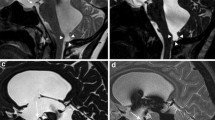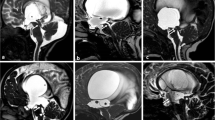Abstract
It has been reported that 3D-FLAIR can reduce the flow artifact resulting from cerebrospinal fluid (CSF) at 1.5 T compared to 2D-FLAIR. Flow-related artifacts tend to be worse at 3 T than at 1.5 T. The purpose of this study was to compare the CSF flow artifacts of 2D-FLAIR and 3D-FLAIR sequences at 3 T in eight healthy volunteers. The grade of CSF-related artifacts were scored through observing the perimedullary cistern, cerebellopontine angle cisterns, fourth ventricule, prepontine cistern, suprasellar cistern, ambient cisterns, sylvian fissures, third ventricle and lateral ventricles. Grading was performed on either axial or sagittal images. The CSF in-flow artifact scores were significantly higher on axial 2D-FLAIR than on axial 3D-FLAIR MPR images in all areas except the bilateral sylvian fissures, and higher on sagittal 2D-FLAIR than on sagittal 3D-FLAIR MPR images in perimedullary, bilateral CP angle and suprasellar cisterns. The CSF-related flow artifacts were significantly reduced by 3D-FLAIR, while structures in the cistern were depicted more clearly, even at 3 T. Further study is necessary to compare the clinical efficacy between 2D-FLAIR and 3D-FLAIR in depicting subtle abnormalities.




Similar content being viewed by others
References
De Coene B, Hajnal JV, Gatehouse P, Longmore DB, White SJ, Oatridge A et al (1992) MR of the brain using fluid-attenuated inversion recovery (FLAIR) pulse sequences. Am J Neuroradiol 13:1555–1564
Hajnal JV, Bryant DJ, Kasuboski L, Pattany PM, De Coene B, Lewis PD et al (1992) Use of fluid attenuated inversion recovery (FLAIR) pulse sequences in MRI of the brain. J Comput Assist Tomogr 16:841–844
Bakshi R, Caruthers SD, Janardhan V, Wasay M (2000) Intraventricular CSF pulsation artifact on fast fluid-attenuated inversion-recovery MR images: analysis of 100 consecutive normal studies. Am J Neuroradiol 21:503–508
Bakshi R, Kamran S, Kinkel PR, Bates VE, Mechtler LL, Janardhan V et al (1999) Fluid-attenuated inversion-recovery MR imaging in acute and subacute cerebral intraventricular hemorrhage. Am J Neuroradiol 20:629–636
Hajnal JV, Oatridge A, Herlihy AH, Bydder GM (2001) Reduction of CSF artifacts on FLAIR images by using adiabatic inversion pulses. Am J Neuroradiol 22:317–322
Herlihy AH, Oatridge A, Curati WL, Puri BK, Bydder GM, Hajnal JV (2001) FLAIR imaging using nonselective inversion pulses combined with slice excitation order cycling and k-space reordering to reduce flow artifacts. Magn Reson Med 46:354–364
Herlihy AH, Hajnal JV, Curati WL, Virji N, Oatridge A, Puri BK et al (2001) Reduction of CSF and blood flow artifacts on FLAIR images of the brain with k-space reordered by inversion time at each slice position (KRISP). Am J Neuroradiol 22:896–904
Oatridge A, Curati WL, Herlihy AH, Hajnal JV, Virji N, Puri BK et al (2001) Evaluation of a FLAIR sequence designed to reduce CSF and blood flow artifacts by use of k-space reordered by inversion time at each slice position (KRISP) in high grade gliomas of the brain. J Comput Assist Tomogr 25:251–256
Tanaka N, Abe T, Kojima K, Nishimura H, Hayabuchi N (2000) Applicability and advantages of flow artifact-insensitive fluid-attenuated inversion-recovery MR sequences for imaging the posterior fossa. Am J Neuroradiol 21:1095–1098
Wu HM, Yousem DM, Chung HW, Guo WY, Chang CY, Chen CY (2002) Influence of imaging parameters on high-intensity cerebrospinal fluid artifacts in fast-FLAIR MR imaging. Am J Neuroradiol 23:393–399
Kallmes DF, Hui FK, Mugler JP III (2001) Suppression of cerebrospinal fluid and blood flow artifacts in FLAIR MR imaging with a single-slab three-dimensional pulse sequence: initial experience. Radiology 221:251–255
Tan IL, van Schijndel RA, Pouwels PJ, Ader HJ, Barkhof F (2002) Serial isotropic three-dimensional fast FLAIR imaging: using image registration and subtraction to reveal active multiple sclerosis lesions. Am J Roentgenol 179:777–782
Tan IL, Pouwels PJ, van Schijndel RA, Ader HJ, Manoliu RA, Barkhof F (2002) Isotropic 3D fast FLAIR imaging of the brain in multiple sclerosis patients: initial experience. Eur Radiol 12:559–567
Tubridy N, Barker GJ, Macmanus DG, Moseley IF, Miller DH (1998) Three-dimensional fast fluid attenuated inversion recovery (3D fast FLAIR): a new MRI sequence which increases the detectable cerebral lesion load in multiple sclerosis. Br J Radiol 71:840–845
Wieshmann UC, Barker GJ, Symms MR, Bartlett PA, Stevens JM, Shorvon SD (1998) Fast fluid-attenuated inversion-recovery imaging: first experience with a 3D version in epilepsy. Neuroradiology 40:483–489
Mugler JP III, Bao S, Mulkern RV, Guttmann CR, Robertson RL, Jolesz FA et al (2000) Optimized single-slab three-dimensional spin-echo MR imaging of the brain. Radiology 216:891–899
Parizel PM, Dijkstra HA, Geenen GP, Kint PA, Versteylen RJ, van Wiechen PJ et al (1995) Low-field versus high-field MR imaging of the knee: a comparison of signal behaviour and diagnostic performance. Eur J Radiol 19:132–138
Griswold MA, Jakob PM, Heidemann RM, Nittka M, Jellus V, Wang J et al (2002) Generalized autocalibrating partially parallel acquisitions (GRAPPA). Magn Reson Med 47:1202–1210
Sodickson DK, Manning WJ, Lori NF, Akbudak E, Shimony JS, Cull TS et al (1997) Simultaneous acquisition of spatial harmonics (SMASH): fast imaging with radiofrequency coil arrays. Magn Reson Med 38:591–603
Heidemann RM, Griswold MA, Haase A, Jakob PM (2001) VD-AUTO-SMASH imaging. Magn Reson Med 45:1066–1074
Maeda M, Koshimoto Y, Uematsu H, Yamada H, Kimura H, Kawamura Y et al (2001) Time course of arterial hyperintensity with fast fluid-attenuated inversion-recovery imaging in acute and subacute middle cerebral arterial infarction. J Magn Reson Imaging 13:987–990
Maeda M, Yamamoto T, Daimon S, Sakuma H, Takeda K (2001) Arterial hyperintensity on fast fluid-attenuated inversion recovery images: a subtle finding for hyperacute stroke undetected by diffusion-weighted MR imaging. Am J Neuroradiol 22:632–636
Maeda M, Yagishita A, Yamamoto T, Sakuma H, Takeda K (2003) Abnormal hyperintensity within the subarachnoid space evaluated by fluid-attenuated inversion-recovery MR imaging: a spectrum of central nervous system diseases. Eur Radiol 13 [Suppl 4]:L192–L201
Noguchi K, Ogawa T, Inugami A, Toyoshima H, Sugawara S, Hatazawa J et al (1995) Acute subarachnoid hemorrhage: MR imaging with fluid-attenuated inversion recovery pulse sequences. Radiology 196:773–777
Noguchi K, Ogawa T, Seto H, Inugami A, Hadeishi H, Fujita H et al (1997) Subacute and chronic subarachnoid hemorrhage: diagnosis with fluid-attenuated inversion-recovery MR imaging. Radiology 203:257–262
Toyoda K, Ida M, Fukuda K (2001) Fluid-attenuated inversion recovery intraarterial signal: an early sign of hyperacute cerebral ischemia. Am J Neuroradiol 22:1021–1029
Maeda M, Tsuchida C (1999) “Ivy sign” on fluid-attenuated inversion-recovery images in childhood moyamoya disease. Am J Neuroradiol 20:836–838
Schwindt W, Kugel H, Bachmann R, Kloska S, Allkemper T, Maintz D et al (2003) Magnetic resonance imaging protocols for examination of the neurocranium at 3 T. Eur Radiol 13:2170–2179
Norris DG (2003) High field human imaging. J Magn Reson Imaging 18:519–529
Author information
Authors and Affiliations
Corresponding author
Rights and permissions
About this article
Cite this article
Naganawa, S., Koshikawa, T., Nakamura, T. et al. Comparison of flow artifacts between 2D-FLAIR and 3D-FLAIR sequences at 3 T. Eur Radiol 14, 1901–1908 (2004). https://doi.org/10.1007/s00330-004-2372-7
Received:
Revised:
Accepted:
Published:
Issue Date:
DOI: https://doi.org/10.1007/s00330-004-2372-7




